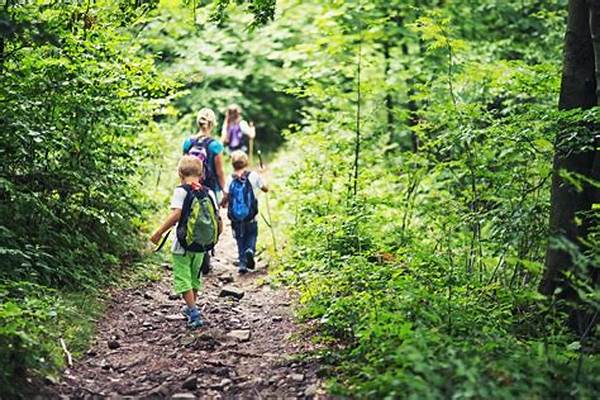Benefits of Nature Walks with Children
Nature walks with children offer an exceptional opportunity to blend education with recreation, fostering a connection between young individuals and the environment. These outdoor excursions serve as a conduit for experiential learning, where children can engage their senses and observe the intricacies of nature in real-time. Exposure to natural surroundings promotes curiosity, stimulates cognitive development, and enhances observational skills. As children walk along trails, they are encouraged to inquire about their surroundings, further cultivating a sense of wonder and an eagerness to learn.
Read Now : Comparing Academy Facilities And Resources
Furthermore, nature walks with children contribute significantly to their physical and mental well-being. The physical activity involved in walking, combined with the fresh air and open spaces, can improve cardiovascular health and promote overall fitness. Additionally, nature has been shown to have a calming effect, reducing stress levels and improving mood. By participating in these walks, children learn to appreciate the tranquility and beauty of the natural world, which can instill lifelong environmental stewardship.
Lastly, these walks present an invaluable time for familial bonding. Families participating in nature walks with children can create lasting memories while fostering meaningful relationships. The shared experience of discovering nature’s wonders fosters communication and cooperation among family members. In this way, nature walks not only benefit children’s development but also strengthen family ties, highlighting the multifaceted advantages of engaging with the natural world.
Preparing for Nature Walks with Children
1. Essential Equipment: Prior to embarking on nature walks with children, it is imperative to equip oneself with proper attire and tools. Sturdy footwear, weather-appropriate clothing, and a backpack with essentials such as water, snacks, and a first-aid kit are crucial.
2. Understanding the Terrain: Knowledge of the selected trail or natural area helps ensure a safe and enjoyable venture. Analyzing the trail difficulty and anticipated weather conditions aids in preparing adequately.
3. Educating Children: Prepare children by providing information about the local flora and fauna. This preparation can stimulate interest and allow for teachable moments during the walk.
4. Setting Objectives: Encouraging children to set simple goals, such as spotting particular animal tracks or identifying certain plants, can add purpose and motivation to the walk.
5. Safety Considerations: Ensuring children understand basic safety rules, such as staying on paths and respecting wildlife, is paramount for a safe and fruitful experience.
Enhancing the Experience of Nature Walks with Children
Incorporating interactive activities can significantly enhance nature walks with children, making them both educational and enjoyable. Activities such as scavenger hunts can engage children and allow them to focus on specific elements of their environment. Such tasks not only heighten their observation skills but also teach them to appreciate biodiversity.
In addition, storytelling can be integrated into nature walks with children, transforming the experience into a narrative journey. By weaving tales about the various plants, animals, or natural phenomena they encounter, children’s imaginations are stimulated, making the excursion more memorable. This blend of imagination and reality serves to deepen their connection with nature.
Enriching Exploration through Nature Walks with Children
1. Observation Skills: Encouraging children to use their senses sharpens awareness and appreciation of their surroundings.
2. Artistic Expression: Encouraging sketching or photography allows children to capture their experiences creatively.
3. Scientific Inquiry: Nature walks with children provide a platform for formulating hypotheses and testing observations.
4. Cultural Learning: Linking natural elements to local history can enrich children’s cultural understanding.
5. Embrace Spontaneity: Flexibility in plans can lead to unexpected discoveries and learning opportunities.
Read Now : Employee Productivity Measurement Tools
6. Interactive Storytelling: Narrating stories related to the environment enhances imaginative engagement.
7. Mapping Skills: Teaching children to read maps or create their own encourages spatial awareness and navigation skills.
8. Reflection Time: Allotting moments of silence allows children to process and internalize their observations and emotions.
9. Team Building: Group activities foster cooperation and communication skills among children.
10. Exploration Techniques: Demonstrating different exploration methods, such as using a magnifying glass, encourages varied perspectives.
11. Problem-Solving Opportunities: Challenges faced during walks can develop critical thinking and adaptability.
12. Quality Time: Uninterrupted time spent together supports bonding and relationship development.
Conclusion: The Lasting Impact of Nature Walks with Children
Nature walks with children offer profound and lasting impacts on both individual children and their families. These walks are a conduit for learning, not merely academic but personal and emotional growth as well. From enhancing observational skills to fostering an appreciation for the environment, these walks have the potential to shape well-rounded, environmentally conscious individuals.
The structured yet free exploration offered by nature walks with children also strengthens familial bonds, creating cherished memories and enhancing communication. The collaborative element inherent in such activities nurtures essential social skills, helping children build and sustain meaningful relationships. Ultimately, the benefits of engaging in nature walks with children underscore their role as a vital activity for fostering holistic development.
Summary of the Advantages of Nature Walks with Children
In summation, nature walks with children provide an unparalleled blend of education, health benefits, and familial bonding. These excursions into nature serve as more than just physical exercise; they represent opportunities for cognitive growth, emotional enrichment, and social development. By engaging in nature walks with children, families can discover a shared understanding and appreciation for the natural world, cultivating environmental consciousness that can shape future generations. Whether observing the intricate patterns of a leaf or listening to the sounds of a forest, children learn to value the simplicity and complexity of nature alike.
Furthermore, nature walks with children facilitate the development of essential life skills. By facing challenges in a natural setting, children enhance their problem-solving abilities and adaptability. The lessons learned and experiences gained through these walks are invaluable, leaving a lasting impression that extends well beyond the trails and into all facets of life. As society continues to evolve, the importance of reconnecting with nature through walks with children cannot be overstated.
